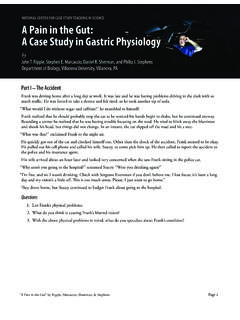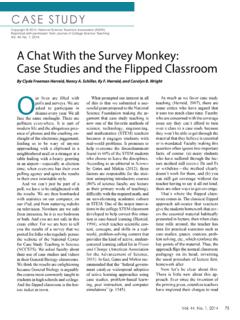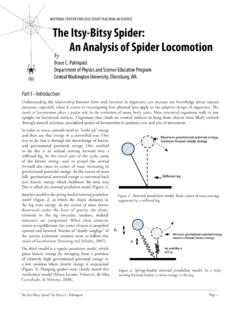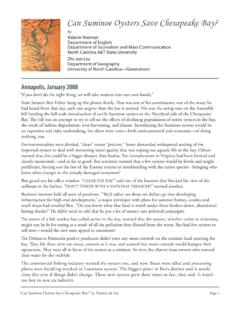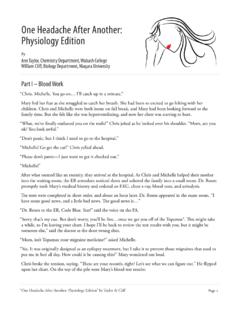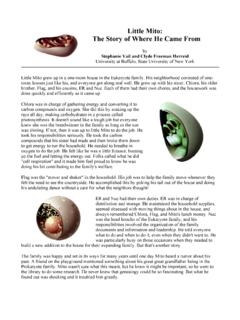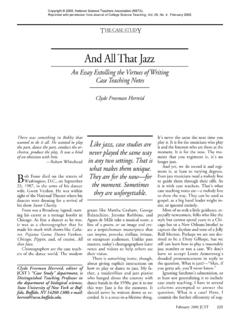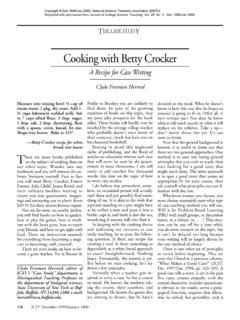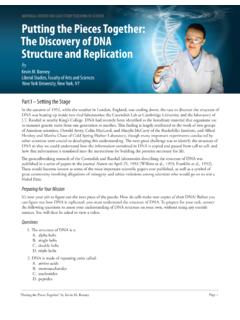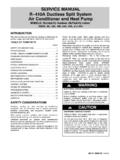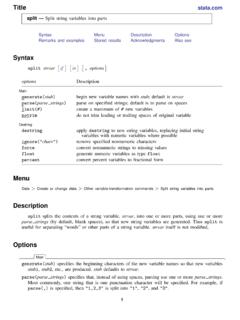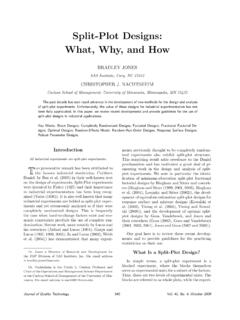Transcription of Split My Brain: A Case Study of Seizure Disorder and Brain ...
1 Split My Brain : A Case Study of Seizure Disorder and Brain Function by Julia Omarzu Department of Psychology Loras College, Dubuque, Iowa Part I Jerrod and Jump Jerrod Hamilton is seven years old. He is an only child and much loved by his parents, Karen and Je , and by his extended family of grandparents, aunts, uncles, and cousins. Jerrod has always been a very active boy. He loves hockey, baseball, swimming at the local pool, climbing trees, and playing with his golden retriever, Jump. Making friends has never been a problem for Jerrod. He has several good friends he plays ball with whenever he can. He also does fairly well in school, although he is not as interested in the classroom as he is in recess. Shortly before Jerrod's seventh birthday, he had a small Seizure . He was out playing with his dad and Jump in the yard, when suddenly he stopped, his right arm twitched a little and he seemed disoriented for a few seconds. Afterward he said he was ne, but his mother Karen thought he was quieter than usual.
2 Both his parents watched him more closely in the following days. Soon he had another couple of episodes of muscle twitching and weakness. During these seizures, Jerrod also stared blankly, moving his head slightly back and forth, and for a minute or two could not respond to his parents. When the seizures ended, Jerrod had no memory of them. Jerrod's parents took him to their pediatrician, Dr. Madeline Sierra, who listened as Jerrod's parents described his symptoms. Before I try to conclude anything, I'd like to order several tests for Jerrod, including an EEG and an MRI scan. I know that sounds a little scary, but the tests are painless and noninvasive. We should get the results back very quickly. Once I see those, I'll know more about what's going on.. A friend of mine said it sounds like Jerrod might have epilepsy, said Karen. Is that what you think? How serious would that be? . Epilepsy is one possibility, replied the doctor. It is a relatively common problem and there are some very good treatments for it.
3 Dr. Sierra went on to explain: The Brain uses electrical energy. The cells of the Brain , called neurons, emit a small electrical charge when they send messages to other cells. This is how the Brain communicates and runs your mind and body. Dr. Sierra interrupted her explanation for a moment to show them a diagram of a neuron. Split My Brain by Julia Omarzu Page 1. In epilepsy, the neurons somehow get out of control, Dr. Sierra continued. The electri- cal activity increases to a level that the Brain can not manage. That produces what we call seizures, where people lose control of their voluntary behaviors for a brief time. Sometimes seizures are nothing more than short lapses of consciousness. Other times they involve con- vulsions or involuntary movements.. Je and Karen looked at each other. That sounds sort of like what's happening to Jerrod, . Je said. Yes, it does. But let's not jump to any conclu- sions. I'd rather wait for the tests. Dr. Sierra paused.
4 I would also recommend something else, she said. This is something that many families nd helpful. Starting today, I suggest that you keep a journal or record of Jerrod's illness. Include his symptoms, tests, informa- tion from doctors, any treatments or therapies. Document everything. I will help you, but ultimately, you and Jerrod are the ones who will have to make the decisions, and there will be lots to think about along the way. I think you will be grateful later to have a record of what you learn and observe.. That evening Karen and Je called a family meeting to share the results of the doctor's visit. You will help Jerrod's family by keeping the record Dr. Sierra suggested. Begin creating Jerrod's records by including the following information in a way that Jerrod's family can use and understand. You are encour- aged to do further research, but you must synthesize the information you get from the research into a new form that suits Jerrod's situation.
5 Do not just cut and paste from the Internet. Jerrod's Records Why is there electrical activity in the Brain ? Describe how it is used by neurons. What happens in the Brain during a Seizure ? What is epilepsy? How is it diagnosed? What are the procedures for doing an EEG test and MRI scan? What type of information does each of these tests provide? (See and ). What are some possible causes of seizures other than epilepsy? Based on the information in the case, what type of seizures does Jerrod appear to be having? What should you do during a Seizure to help Jerrod? What are some treatments for epilepsy? Split My Brain by Julia Omarzu Page 2. Part II A Di cult Decision Jerrod's tests were done right away, and his parents met again with Dr. Sierra. Jerrod's symptoms were esca- lating. He had daily seizures, and they included disorientation as well as uncontrollable repetitive movements on the right side of his body. He often felt tired and weak after the seizures.
6 Why is this happening to Jerrod? his mother asked. Did he get hit in the head or something? . Dr. Sierra shook her head. Jerrod's test results show no evidence of an injury like that. The other good news is that there is nothing to indicate a Brain tumor. I am more con dent that we are dealing with a form of epilepsy, which is probably very treatable. It's also unlikely to be caused by anything he did or you did. However, given the rapid change in Jerrod's symptoms, I would like to refer you to a specialist in neurologi- cal disorders. Our o ce will help set up an appointment.. Now, I want you to know I'm not abandoning you on this. I'll be following Jerrod carefully, too. But I don't think we should take any chances with this little guy. She smiled and ru ed Jerrod's hair. Dr. Sierra's referral sent Jerrod and his parents to a neurologist who specialized in Seizure disorders. Dr. Benjamin Singh questioned Jerrod and his parents carefully about the seizures.
7 He then opened up the folder with Jerrod's test results and discussed them with Karen and Je . Here is the output from Jerrod's EEG exam. Dr. Singh showed them a printout. This test shows us the level of electrical activity in Jerrod's Brain . There is a particular pattern of spikes here that shows his Seizure activity. Based on these tests and some other indications, I believe Jerrod's seizures are what we call partial'. seizures. This means that they only involve part of the Brain . And right now, his MRI scan is okay.. Jerrod's parents looked at each other with some relief. However, the doctor added, if we do not nd a way to reduce or control the current level of Seizure activity I am afraid that Jerrod's Brain will begin to show some damage, regardless of how much of it is now involved. Fortunately, there are several treatment options available to us. Let's start with a Seizure medica- tion.. Dr. Singh prescribed medication to help treat Jerrod's Disorder .
8 The rst medication didn't succeed, so Dr. Singh and Dr. Sierra conferred and then tried another. After some time and other combinations of medica- tions, it became clear that this type of treatment would be problematic for Jerrod. His seizures were becom- ing more severe and more frequent. The doctors ordered more tests and then Dr. Singh met with Je and Karen. Dr. Singh pulled out Jerrod's records. Here is a picture from Jerrod's new MRI scan. Look at this area in the left side of the Brain . We are beginning to see some slight abnormalities here that indicate Jerrod's Brain is starting to be damaged by the seizures.. Je asked, What is going on? Why don't the medicines work? You've said there's no injury or tumor. So, is this a condition he inherited from us somehow? Or is it an allergic reaction to something? . Split My Brain by Julia Omarzu Page 3. No, Dr. Singh reassured them. Most likely none of those things are causing Jerrod's problem. This is also not your fault or Jerrod's fault.
9 I believe that Jerrod has a Disorder called Rasmussen Syndrome. Unfortu- nately, we don't know what causes it. Some people suspect it may be some type of viral infection, but we don't know for sure. So, likely there is nothing you could have done to prevent it. It involves the type and frequency of seizures we are seeing in Jerrod and usually occurs in children of about Jerrod's age. I must warn you that it is a progressive and potentially serious illness that often does not respond to medication.. Dr. Singh went on to describe another type of more drastic treatment that might work in Jerrod's case. The upper part of the Brain , the cerebrum, is divided into two halves, or two hemispheres, Dr. Singh explained. In some cases of severe Seizure disorders, Seizure activity seems to be concentrated in one half or hemisphere of the Brain . This is the case in Jerrod's illness.. Dr. Singh showed them a diagram of the Brain . In Jerrod's case, his Seizure activity is located primarily in the left hemisphere of his Brain .
10 Sometimes, we can control or even eliminate Seizure activity by removing the portion of the Brain which is su ering. We call this a functional hemispherectomy.. What do you mean, removing'? You take out his Brain ? Karen was horri ed. Split My Brain by Julia Omarzu Page 4. Not his entire Brain , just the parts that show abnormal activity. In Jerrod's Brain , that would mean a large part of his left hemisphere. We would remove Jerrod's left temporal lobe, part of his left frontal lobe, and perhaps some areas in his parietal and occipital lobes. We would also sever the corpus collosum, the band of tissue that connects the two hemispheres and allows them to communicate. We would leave intact Jerrod's thalamus, amygdala, hippocampus, and other deep structures of the Brain .. Dr. Singh looked at their worried faces. It sounds terrible, but there have been quite a number of these surgeries performed. We have an excellent team of specialists with a great deal of experience performing this type of surgery and with the rehabilitation that would follow.
